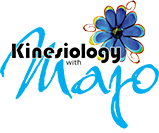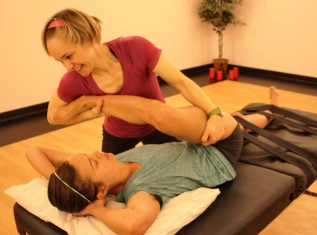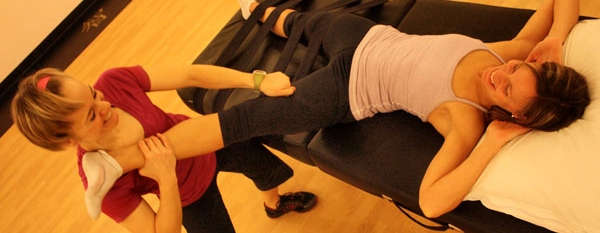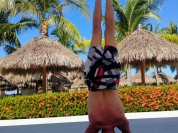Fascia is a three dimensional soft fibrous tissue that surrounds and connects muscles, bones, joints, nerves, organs and blood and lymph vessels. It is also a continuous web-like sheath surrounded with an interactive gel type substance, together filling the void between all other structures. When healthy, this communicative and dynamic tissue moves fluidly, is loose and reactive to tension and pressure; therefore, continuously adapts its shape to allow free movement of the body. In response to injuries, repetitive motion disorders, deficient posture, aging, illness and stress, unhealthy responses can develop such as fascial adhesions, scar tissue, muscle knots and taut muscle bands, all restricting the body’s freedom of movement and functional efficiency.
Symptoms of fascial impairments may be such as:
- generalized or focalized ache or pain in the muscles or joints
- feeling of stiffness and tension
- decreased range of motion (ROM) in the muscles and joints
- headaches
- general fatigue
- motor and postural compensations
- muscle weakness
- decreased kinesthesia (proprioception)
- decreased coordination
- decreased balance
- decreased overall sport performance
Majo uses a combination of manipulative techniques that work on improving fascia pliability, structure and function. Here are some examples:
NeuroKinetic Therapy™ (NKT™) uses isolated muscle testing to investigate motor pattern dysfunctions. Body movements are produced after the Peripheral Nervous System receives specific commands from the Central Nervous System via neurons carrying impulses. In other words the brain and spinal cord receive and analyse information from our intentions and 5 senses (such as touch and sight) and send back to our muscles action or reaction orders. Stressful life events such as body injuries, surgeries, illnesses and excessive anxiety may disturb the efficiency of the Motor Control Center that organizes the body movement patterns. To overcome the inability or difficulty to perform tasks, due to physical harms and myofascial changes, the neuromuscular system uses compensatory movement patterns as a tactic to function. This require a set of muscles to overwork for others that become less active to protect themselves. The optimal motor patterns will be reintegrated only if they are specifically retrained; otherwise with time muscle compensations will lead to new problems and even injuries. NeuroKinetic Therapy™ can identify these Facilitation/Inhibition relationships in the body and help reprogram the brain to reintegrate proper muscle function by waking up the more efficient neural pathways.
Fascial Stretch Therapy™ (FST™) is the technique of Stretch to Win® System and uses assisted Proprioceptive Neuromuscular Facilitation (PNF) stretching techniques that require consecutive short contraction and relaxation of the agonist muscles (the muscles to be stretched). The stretching is performed while the muscles are relaxing. The technique relies on a physiological phenomenon in which there is an interval of “forced relaxation” wherein the muscle cells cannot be stimulated immediately after excitation or contraction. This interval of “forced relaxation” is used for enhancing the stretching response to reach greater ranges of motion.
Active Isolated Stretching (AIS): The Mattes Method uses assisted stretching techniques that require repeated contraction of the antagonist muscles (the muscles which contract in opposition to the ones being stretched), while stretching the agonist muscles into their full range of motion. The Reciprocal Inhibition Reflex forces the agonist muscles to automatically relax while their antagonist muscles are contracting. The relaxation state of the agonist muscles created by this technique is exploited to increase muscle flexibility.
Myofascial Release (MFR) involves hands-on maneuvers that may feel more like massage therapy. Sometimes good hand grip is required to manipulate the skin and the superficial fascia more effectively: the use of water may be helpful. Other times good glide is more beneficial to act deeper into the skin, fascia and muscles: the use of cream or oil may be required. The body may be positioned carefully and with the use of pillows in order to treat muscle in a slack and relaxed state. This technique is called Strain Counterstrain (SCS) or Positional Release Therapy (PRT). MFR is particularly successful for releasing localized tension such as fascial adhesions, scar tissue, muscle knots and taut muscle bands.
Soft Tissue Release (STR) includes the use of AIS as explained above, but also adding pressure on the muscles that are being stretched.
NEW! Massage Therapy stems from an old traditional holistic system of manual techniques aiming to heal the mind and body of its cumulative stress, and is still largely performed today for relaxation and therpeutic means. Oil is applied to promote fluidity in continuous and smooth stroking. Plus or less pressure is used depending on the person's needs and the session's goals. Different techniques can be also incorporated to the here mainly practiced swedish massage style, such as passive assisted streching, joint traction, and more.
*Majo encourages good communication during each treatment so all techniques are performed in within each individual level of tolerance.
All of these techniques most likely result in immediate, long-lasting improvements in mobility, function and performance and work due to:
- re-organizing the anatomical structure of the fascia (e.g. reduction of fascial adhesions, scar tissues, muscle knots, and taut muscle bands)
- increasing soft tissue elasticity (such as fascia, muscles, blood vessels and nerves)
- increasing muscle strength through their full range of motion
- improving passive range of motion (PROM) of the muscles and joints
- improving active range of motion (AROM) of the muscles and joints
- increasing joint capsule flexibility and joint space through gentle joint traction used throughout the techniques
Training fascia plays a positive role in human well-being as it helps:
- reduce chronic pain
- rehabilitate soft tissue injuries
- improve posture
- improve functional capacity (what one can do on a day to day basis)
- enhance physical performance (strength, power, speed, coordination, agility, balance, endurance and flexibility)
- reduce risk of injuries
- improve ability to recover from intense training and competition
- increase muscle ability of relaxation
- decrease stress
Majo will ensure you know what to do at home to further improve your fascial health by teaching you specific self fascial release techniques and teaching you to use tools such as a massage ball, trigger point ball, foam roll, stick roller, trigger wheel, and stretching strap.
Majo likes to first run an assessment including a range of motion, functional movement and posture analysis, as well using soft tissue palpation, to help her find the areas causing problems and guide her through her treatments.
Structures like fascia, muscles, and nerves need to move freely to be able to fully function. Majo’s hands-on techniques will help you gain better mobility faster by most effectively releasing fascial and muscular tension.
Article written by: Majorie Lauzon
Copyright 2012
References: .
- Thomas W. Myers, Anatomy Trains: Myofascial Meridians for Manual and Movement Therapists, Second Edition, CHURCHILL LIVING STONE ELSEVIER, 2009
- Ann Frederick & Chris Frederick, Stretch to Win: Flexibility for improved speed, power and agility, Human Kinetics, 2006
- Aaron L. Mattes, Active Isolated Stretching: The Mattes Method, Published by Aaron L. Mattes, 2000
- Theresa Schmidt, Myofascial Release: Art of the soft Tissue Mobilization, Cross Published by Country Education & Theresa Schmidt, 2005
- Theresa Schmidt, Integrated Neuromuscular Re-Education Seminar DVD, Educise Resources Inc., 2009
- Jim Bilotta, Soft Tissue Release: Practical guide for health care professionals, Published by Jim Bilotta, 2006
- David Weinstock, NeuroKinetic Therapy: An Innovative Approach to Manual Muscle Testing, North Atlantic Books, 2010



